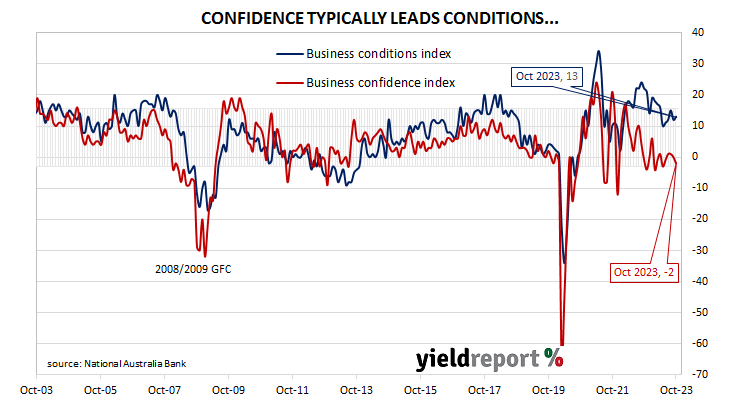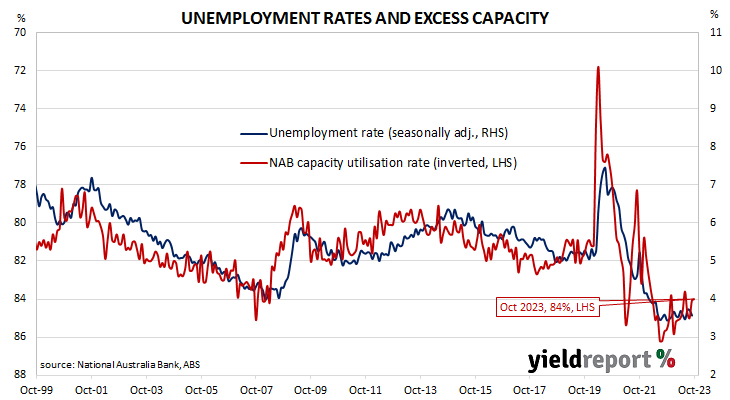Summary: Business conditions improve in October; business pessimism deepens, well below average; broad theme of resilience in current indicators but weaker outlook in forward indicators continues; ACGB yields barely move; rate-rise expectations unchanged; Westpac: economy in midst of gradual slowdown; will likely broaden; capacity utilisation rate declines, still at elevated level.
NAB’s business survey indicated Australian business conditions were robust in the first half of 2018, with a cyclical-peak reached in April of that year. Readings from NAB’s index then began to slip and forecasts of a slowdown in the domestic economy began to emerge in the first half of 2019 as the index trended lower. It hit a nadir in April 2020 as pandemic restrictions were introduced but then improved markedly over the next twelve months and have subsequently remained at robust levels.
According to NAB’s latest monthly business survey of around 400 firms conducted in last week of October, business conditions improved modestly, maintaining a level which is above average. NAB’s conditions index registered 13 points, up 2 points from September’s revised reading.
However, business confidence deteriorated for a second consecutive month. NAB’s confidence index declined from September’s revised reading of zero to -2 points, well below the long-term average. Typically, NAB’s confidence index leads the conditions index by one month, although some divergences have appeared from time to time.
“The broad theme of resilience in current indicators of activity but a weaker outlook in forward looking indicators continued in October, down slightly in September but remaining above average at +11 index points, where the index has hovered since May,” said NAB senior economist Brody Viney.
The report was released on the same day as the latest Westpac-Melbourne Institute consumer sentiment survey and Commonwealth Government bond yields barely moved on the day. By the close of business, 3-year and 10-year ACGB yields had both returned to their respective starting points at 4.30% and 4.68% while the 20-year yield finished 1bp lower at 4.97%.
In the cash futures market, expectations regarding further rate rises remained essentially unchanged. At the end of the day, contracts implied the cash rate would increase from the current rate of 4.32% and average 4.335% through December and 4.405% in February. May 2024 contracts implied a 4.49% average cash rate while August 2024 contracts implied 4.48%, 16bps more than the current rate.
Westpac economist Ryan Wells said the latest reading “and is consistent with official evidence that the Australian economy is in the midst of a gradual slowdown.”
“We continue to anticipate that this slowdown will broaden as the full impact of high inflation and the RBA’s rapid tightening cycle continues to materialise,” he added. “Output growth has already slowed from 2.7% in 2022 to a 1.5% annualised pace over the first half of 2023 and we expect a further slowing to around a 1.0% annualised pace for both the second half of 2023 and the first half of 2024.”
NAB’s measure of national capacity utilisation declined from September’s revised reading of 84.1% to 84.0%, a level which is still elevated from a historical perspective. All eight sectors of the economy were reported to be operating at or above their respective long-run averages.
Capacity utilisation is generally accepted as an indicator of future investment expenditure and it also has a strong inverse relationship with Australia’s unemployment rate.



